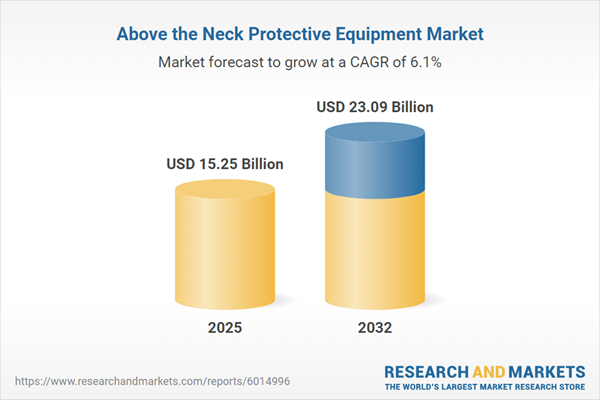Speak directly to the analyst to clarify any post sales queries you may have.
Above the neck protective equipment is transforming workplace safety by integrating advanced materials and digital technologies, helping organizations safeguard their workforce amid evolving compliance demands and operational risks. This report offers targeted insights tailored for senior decision-makers considering current market opportunities and innovation strategies.
Market Snapshot: Above the Neck Protective Equipment Market Size & Growth
The Above the Neck Protective Equipment Market grew from USD 14.37 billion in 2024 to USD 15.25 billion in 2025 and is projected to reach USD 23.09 billion by 2032, at a CAGR of 6.10%. This steady expansion is fueled by regulatory requirements, ongoing industrial development, and a rising focus on workforce health and safety. Persistent demand from industries such as construction, healthcare, manufacturing, and mining continues to drive innovation and competitive advancement in this sector.
Scope & Segmentation of the Above the Neck Protective Equipment Market
- Product Types: Face shields (full and half face), goggles (chemical splash, non-ventilated, ventilated), helmets (bump caps, hard hats), respirators and masks (disposable including N95, N99, P100; reusable full and half facepieces), safety glasses (anti-fog, photochromic, prescription, UV protective), welding helmets (auto-darkening, passive)
- End Users: Chemical, construction, healthcare, manufacturing, mining, oil & gas
- Distribution Channels: Direct, distributors, e-commerce
- Material Types: ABS, fiberglass, high-density polyethylene (HDPE), polycarbonate
- Price Ranges: High, medium, low
- Regional Coverage: Americas (North America: United States, Canada, Mexico; Latin America: Brazil, Argentina, Chile, Colombia, Peru), Europe, Middle East & Africa (Europe: United Kingdom, Germany, France, Russia, Italy, Spain, Netherlands, Sweden, Poland, Switzerland; Middle East: United Arab Emirates, Saudi Arabia, Qatar, Turkey, Israel; Africa: South Africa, Nigeria, Egypt, Kenya), Asia-Pacific (China, India, Japan, Australia, South Korea, Indonesia, Thailand, Malaysia, Singapore, Taiwan)
- Key Competitors: 3M Company, Honeywell International Inc., MSA Safety Incorporated, Drägerwerk AG & Co. KGaA, Ansell Limited, Gentex Corporation, UVEX Arbeitsschutz GmbH & Co. KG, Bollé Brands, JSP Limited, Pyramex Safety Products LLC
Key Takeaways for Decision-Makers
- Product innovation incorporates ergonomic designs, lightweight composites, and integration of sensors for real-time environmental monitoring, moving protective gear beyond traditional roles.
- Regulatory frameworks are intensifying, prompting harmonized testing and certifications that shape the pace and direction of product development across regions.
- End user requirements are driving manufacturers to provide highly specialized solutions addressing unique sectoral hazards, from advanced respiratory systems in chemical plants to durable helmets in mining.
- Distribution strategies are evolving, with a notable increase in direct sales and e-commerce channels facilitating quicker delivery and customization.
- Material advancements, such as nanocoatings and modular engineering, are enhancing impact resistance and user comfort without compromising compliance or cost-effectiveness.
- Leading companies differentiate through collaboration with technology providers, investment in R&D, and strategic partnerships to navigate both compliance and competitive pressures.
Tariff Impact: 2025 United States Tariffs and Global Supply Chain Implications
Recent United States tariff introductions have disrupted global supply chains by raising raw material costs, leading manufacturers to reassess sources and accelerate regional procurement. This shift strengthens supply chain resilience and pushes businesses toward localized manufacturing and diversified supplier networks, although it brings new complexities to qualification and process alignment. Organizations that secure long-term agreements or invest in domestic capabilities are better positioned to withstand price adjustments and remain competitive amidst fluctuating trade policies.
Primary Keyword: Above the Neck Protective Equipment
Research Methodology & Data Sources
This analysis draws on a mix of qualitative interviews with safety professionals, procurement leads, and regulatory experts, combined with quantitative assessments of procurement metrics, patent activity, and secondary literature. Rigorous peer review and validation ensure reliability and objectivity in all findings.
Why This Report Matters
- Enables leadership teams to benchmark current safety programs and procurement strategies against evolving regulatory and technological standards.
- Delivers actionable insights for optimizing product portfolios and supply chains in response to shifting industry dynamics and compliance challenges.
- Supports expansion planning by identifying growth opportunities and highlighting critical differentiators across regions, end users, and distribution channels.
Conclusion
The Above the Neck Protective Equipment Market is adapting swiftly to technological, regulatory, and operational shifts. Stakeholders who harness these insights will strengthen their competitive positioning and enhance workforce protection in complex environments.
Additional Product Information:
- Purchase of this report includes 1 year online access with quarterly updates.
- This report can be updated on request. Please contact our Customer Experience team using the Ask a Question widget on our website.
Table of Contents
3. Executive Summary
4. Market Overview
7. Cumulative Impact of Artificial Intelligence 2025
Companies Mentioned
The companies profiled in this Above the Neck Protective Equipment market report include:- 3M Company
- Honeywell International Inc.
- MSA Safety Incorporated
- Drägerwerk AG & Co. KGaA
- Ansell Limited
- Gentex Corporation
- UVEX Arbeitsschutz GmbH & Co. KG
- Bollé Brands
- JSP Limited
- Pyramex Safety Products LLC
Table Information
| Report Attribute | Details |
|---|---|
| No. of Pages | 191 |
| Published | November 2025 |
| Forecast Period | 2025 - 2032 |
| Estimated Market Value ( USD | $ 15.25 Billion |
| Forecasted Market Value ( USD | $ 23.09 Billion |
| Compound Annual Growth Rate | 6.1% |
| Regions Covered | Global |
| No. of Companies Mentioned | 11 |









